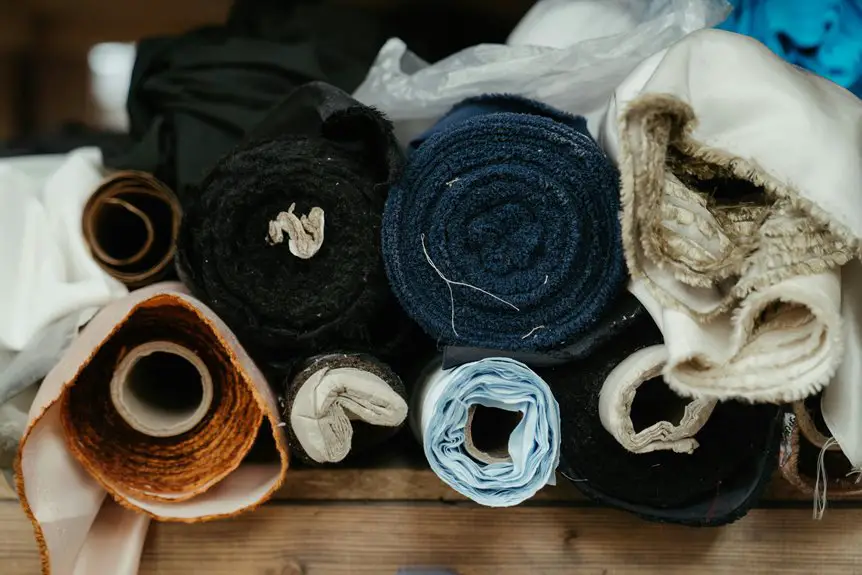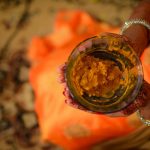When choosing jute fabric rolls, you’ll find widths usually range from 36 to 60 inches, with 48 inches being common, and lengths vary from 25 to 100 yards. Prices depend on fiber quality, weave density, and roll size. Look for strong, uniform fibers and tight weaves for durability. You can find jute rolls from eco-friendly suppliers online or local fabric stores. If you want to explore sizing tips, pricing factors, and creative uses, there’s more to discover ahead.
Table of Contents
Key Takeaways
- Jute fabric rolls commonly range from 36 to 60 inches in width, with lengths between 25 to 100 yards depending on project needs.
- Pricing varies based on fiber quality, roll size, weave density, and eco-friendly processing methods.
- Look for strong, uniformly thick fibers and tight weaves to ensure durable, high-quality jute fabric.
- Popular purchase locations include online fabric retailers, eco-friendly craft stores, and specialty textile suppliers.
- Always check product specifications, read reviews, and compare prices before buying jute rolls online.
Understanding Jute Fabric and Its Uses
Jute fabric, known for its strength and eco-friendliness, offers you a versatile material suitable for various applications. When you choose jute, you’re opting for a natural fiber that’s biodegradable and renewable, making it an excellent choice for sustainable projects.
You can use jute in home décor, such as rugs, curtains, and cushion covers, thanks to its coarse texture and durability. It’s also popular in agriculture for sacks and bags, helping you store produce safely.
Additionally, crafters rely on jute for making twine, ropes, and even eco-friendly gift wraps. Its breathability and rough texture mightn’t suit clothing, but for practical, robust uses, jute fabric is hard to beat. You’ll find it both functional and environmentally responsible.
Common Sizes of Jute Fabric Rolls
When selecting fabric rolls for your project, understanding the common sizes available can save you time and effort.
Jute fabric rolls typically come in widths ranging from 36 to 60 inches, with 48 inches being the most common. The length of these rolls varies widely, usually between 25 to 100 yards, depending on the supplier.
If you’re working on smaller crafts, shorter lengths might be suitable, but larger projects will benefit from longer rolls to minimize seams.
Keep in mind that the thickness or weight of the jute fabric can also affect how much material you’ll need.
Factors Influencing the Price of Jute Fabric Rolls
When you shop for jute fabric rolls, you’ll notice that material quality plays a big role in the price.
The size and length of each roll also affect how much you’ll pay.
Plus, market demand can cause prices to shift unexpectedly.
Material Quality Variations
Although several factors come into play, the quality of the material stands out as the main driver behind the price differences in fabric rolls.
When you choose jute fabric, pay attention to fiber strength, fineness, and uniformity. Higher-grade fibers produce smoother, more durable fabric that costs more. You’ll also notice that premium jute has fewer impurities and is less prone to shedding or fraying, which adds value.
The weaving technique matters too—tighter, consistent weaves demand better craftsmanship and increase the price. Additionally, organic or eco-friendly processing methods can raise costs but offer better environmental impact.
Roll Dimensions Impact
Understanding the quality of jute fibers helps you choose the right fabric, but the size of the rolls you buy also plays a big role in cost.
Larger rolls often offer better per-yard pricing since manufacturers save on packaging and handling. However, bigger rolls might require more storage space and can be harder to manage.
Here are four key ways roll dimensions impact price:
- Length of the roll – Longer rolls typically lower the cost per yard.
- Width of the fabric – Wider fabric increases material quantity, affecting price.
- Roll diameter – Larger diameters can signal more fabric but may raise shipping costs.
- Weight of the roll – Heavier rolls mean more material, influencing overall price and transport fees.
Keep these factors in mind when selecting your jute fabric rolls.
Market Demand Trends
Because market demand fluctuates based on various factors, the price of jute fabric rolls can change rapidly.
You’ll notice that seasonal demand, especially around festivals and agricultural seasons, greatly impacts prices. When industries like packaging or home décor increase their orders, demand spikes, driving prices up.
Conversely, if synthetic alternatives gain popularity, jute’s demand may drop, lowering prices. Global economic conditions, including trade policies and raw material availability, also play an essential role.
If you watch market trends closely, you can anticipate price shifts and plan your purchases accordingly. Staying informed about these demand trends helps you secure the best deals and avoid overpaying for jute fabric rolls when the market tightens.
Comparing Quality: What to Look For in Jute Fabric
When comparing jute fabric, focus on fiber strength and texture to guarantee durability and comfort.
Check the weave density, as tighter weaves typically mean better quality and longevity.
Also, pay attention to the finish, which affects both appearance and performance.
Fiber Strength and Texture
Although jute fabric may look similar at first glance, its fiber strength and texture can vary widely, affecting both durability and feel.
When choosing jute fabric, you want to pay close attention to these factors to guarantee your project lasts and looks great.
- Check the fiber thickness—thicker fibers usually mean stronger fabric.
- Feel the texture; smoother fibers indicate finer quality and less brittleness.
- Look for uniformity in the fibers; consistent texture suggests better processing.
- Test fiber flexibility; strong fibers should bend without breaking easily.
Weave Density and Finish
Weave density and finish play an essential role in determining the quality and durability of jute fabric.
When you examine weave density, look for tightly woven fibers, which indicate stronger, longer-lasting fabric. Loose weaves tend to be less durable and can fray easily. You want a consistent weave pattern without gaps or irregularities.
The finish affects both the fabric’s texture and resistance to wear. A smooth, well-applied finish enhances the fabric’s strength and gives it a refined appearance. Avoid fabrics with rough or uneven finishes, as they may snag or deteriorate faster.
Popular Suppliers and Retailers for Jute Fabric Rolls
Finding reliable suppliers and retailers for jute fabric rolls can make all the difference in your project’s success. You’ll want sources that offer consistent quality, fair pricing, and good customer service.
Here are some popular options to take into account:
- Local Textile Markets – Great for inspecting fabric in person and negotiating prices.
- Specialty Fabric Stores – They often stock high-quality jute with detailed product info.
- Online Wholesale Platforms – Convenient for bulk orders and comparing multiple suppliers quickly.
- Eco-Friendly Product Retailers – Focus on sustainable sourcing, providing organic or ethically harvested jute.
Choosing the right supplier guarantees you get fabric that suits your needs without surprises.
Selecting the right supplier ensures your fabric meets expectations and avoids unexpected issues.
Explore these options to find the best match for your project’s scale and budget.
Tips for Buying Jute Fabric Rolls Online
Shopping for jute fabric rolls online opens up a wider range of options than local stores can offer. To get the best deal, first check fabric specifications like weight, weave, and width to guarantee it suits your project.
Always read customer reviews to gauge quality and seller reliability. Compare prices across multiple sites, but beware of unusually low prices—they might indicate inferior quality.
Confirm shipping costs and return policies before buying, so you’re not surprised later. If you’re unsure about the texture or color, order a small sample first.
Finally, look for sellers with responsive customer service; it makes resolving issues much easier. Following these tips will help you confidently select the right jute fabric roll for your needs.
Creative Projects You Can Make With Jute Fabric Rolls
Jute fabric rolls offer countless creative possibilities, whether you’re crafting home décor, accessories, or gift wraps.
Endless creative uses for jute fabric rolls, perfect for home décor, accessories, and gift wrapping.
You can easily transform this natural fiber into stylish and eco-friendly items that add rustic charm to any space. Here are some ideas to get you started:
- Table runners and placemats – Cut and hem jute to create durable, textured table settings.
- Wall hangings – Weave or layer jute strips for unique, earthy art pieces.
- Tote bags – Sew sturdy, reusable bags perfect for shopping or casual outings.
- Gift wraps and bows – Use jute to wrap presents for an organic, elegant finish.
With jute fabric rolls, you can craft practical and decorative projects that enhance everyday living with natural appeal.
Frequently Asked Questions
How Should I Store Jute Fabric Rolls to Maintain Quality?
Oh sure, just toss your jute rolls in a damp corner and watch them magically stay fresh! Seriously, keep them dry, cool, and away from sunlight. Roll loosely to prevent creases and avoid pests for lasting quality.
Is Jute Fabric Biodegradable and Eco-Friendly?
Yes, jute fabric is biodegradable and eco-friendly. You’ll appreciate that it decomposes naturally, reducing environmental impact. Using jute helps support sustainable practices, making it a great choice if you’re environmentally conscious.
Can Jute Fabric Be Dyed or Printed On?
You can definitely dye or print on jute fabric, but keep in mind its coarse texture might affect color vibrancy. Using natural or fabric-specific dyes works best to achieve lasting, eco-friendly results on your jute material.
What Is the Best Way to Clean Jute Fabric?
Want to turn your jute into a mud sculpture? Don’t! Instead, gently vacuum or spot-clean with mild soap and cold water. Avoid soaking—it’s not a spa day for jute, so keep it dry and happy!
Are There Any Health Concerns When Handling Jute Fabric?
When handling jute fabric, you might experience skin irritation or allergies due to its coarse fibers. Always wear gloves if you have sensitive skin, and work in a well-ventilated area to avoid inhaling dust or fibers.
- Does Chiffon Fabric Stink - July 15, 2025
- Does Chiffon Fabric Affect the Economy - July 15, 2025
- Does Cotton Fabric Have a Nap - July 15, 2025







